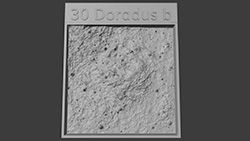CXC Home | Search | Help | Image Use Policy | Latest Images | Privacy | Accessibility | Glossary | Q&A
1
X-ray & Infrared Images of 30 Doradus BCredit: X-ray: NASA/CXC/Penn State Univ./L. Townsley et al.; Optical: NASA/STScI/HST; Infrared: NASA/JPL/CalTech/SST; Image Processing: NASA/CXC/SAO/J. Schmidt, N. Wolk, K. Arcand
This deep dataset from Chandra of the remains of a supernova known as 30 Doradus B (30 Dor B) reveals evidence for more than one supernova explosion in the history of this remnant. Unusual structures in the Chandra data cannot be explained by a single explosion. These images of 30 Dor B also show optical data from the Blanco telescope in Chile, and infrared data from Spitzer. Additional data from Hubble highlights sharp features in the image.
2
3D Printable Files: 30 Doradus B(3D Print Credit: NASA/CXC/A. Jubett, using software by Tactile Universe/N. Bonne & C. Krawczyk & Blender)
This tactile plate features a physical relief map based on the intensity of X-ray, optical & infrared data, depicting a large region of space where stars have been continuously forming for the past eight to ten million years. At the center of this complex landscape of gas clouds is a supernova remnant known as 30 Doradus B. The remnant likely contains the remains of at least two exploded stars.
The entire image is awash in intricate clouds, and swathes of superheated gas. At our upper lefthand corner is a thick cloud with a texture like cotton candy. At our lower and upper right is a network of clouds that resemble streaks of thick syrup floating in water. A layer of wispy cloud appears to drape across the entire image, but is most evident at our lower left which is free of overlapping gas. Specks of light, which are stars, dot the plate.
In the center of the frame is a raised cloud, flecked with dots, and streaked with lightning-like veins. This is 30 Doradus B, which is delineated by a faint shell of X-rays identified by Chandra. Within this supernova remnant are high energy shocks and winds of particles blowing away from a pulsar.
The entire image is awash in intricate clouds, and swathes of superheated gas. At our upper lefthand corner is a thick cloud with a texture like cotton candy. At our lower and upper right is a network of clouds that resemble streaks of thick syrup floating in water. A layer of wispy cloud appears to drape across the entire image, but is most evident at our lower left which is free of overlapping gas. Specks of light, which are stars, dot the plate.
In the center of the frame is a raised cloud, flecked with dots, and streaked with lightning-like veins. This is 30 Doradus B, which is delineated by a faint shell of X-rays identified by Chandra. Within this supernova remnant are high energy shocks and winds of particles blowing away from a pulsar.
Return to: NASA Telescopes Start the Year With a Double Bang (January 3, 2024)







